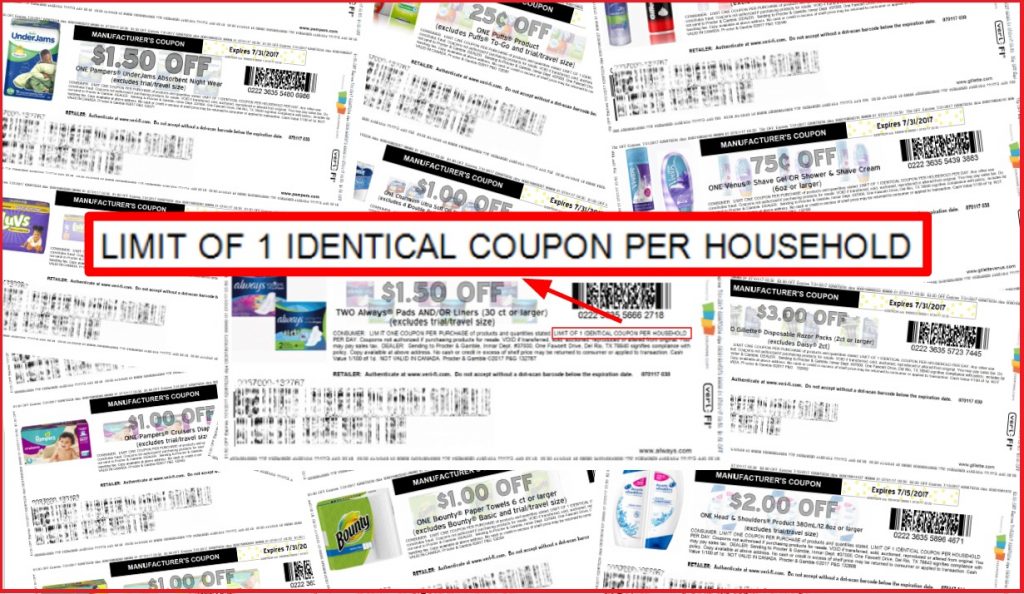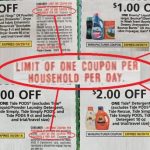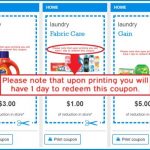
Well, it’s official – Procter & Gamble would rather you just didn’t use its coupons anymore.
At least that’s the takeaway many couponers are likely to have, now that P&G has followed up its new brandSAVER limit of “2 like coupons” with an even more draconian change –
Now, P&G’s printable coupons limit you to using just one.
Just go to Coupons.com or P&G’s website and print a coupon for Pampers, Always, Charmin or just about any other P&G product, and look at the fine print. It now reads “Limit of 1 identical coupon per household per day”.
The change took effect with the new July printable coupons released this past weekend, concurrent with the release of the July brandSAVER coupon insert. A handful of P&G printables had already begun phasing in the new limit, but now virtually all P&G brands limit you to using just one like coupon at a time, when printing from home. The sole exception right now appears to be Align supplements, which generously allow you to use two.
So do you want to print some coupons to buy some boxes of tissues this week? Hope you enjoy that 25-cent Puffs printable, because you can only use one and the rest of your tissues will be full price (unless you go shopping every day and buy one box at a time). Need to stock up on Gillette or Satin Care shave gel? Go ahead and print a single coupon for 50 cents off, and don’t spend all of your savings in one place!
The aim of reducing the brandSAVER “like coupon” limit from four to two, was to discourage too few shoppers from using too many coupons to buy too many products at a discount, a P&G spokesperson explained last week. “The vast majority of consumers only utilize one or two coupons at a time, and so making this the standard practice will allow us to ensure more shoppers can take advantage of our brands and are able to find our products,” Vicky Schooler told Coupons in the News.
But if “4 like coupons” wasn’t enough to prevent shelf-clearing (and, really, does buying four like products constitute clearing a shelf?) then it’s unclear how changing it to “2 like coupons” will solve the problem. And “1 like coupon” seems more punitive than preventative.
So we’re left to speculate what the true motive is here – expanding P&G products’ appeal and availability to more shoppers, or reducing their appeal to couponing customers who just aren’t considered profitable?
The changes come as P&G is pushing its digital coupons as an alternative to paper. And as more shoppers use digital coupons, they’re becoming more accustomed to digital’s limitations – you can only use one digital coupon, on a single product.
So if shoppers are accepting of that limit, and are willing to continue using digital coupons, then why not apply the same limit to printable coupons? It’s similar logic to what led many retailers to do away with double coupons – digital coupons aren’t subject to doubling, and shoppers seem fine with that, so why should paper coupons be doubled anymore?
Schooler points out that printables are indeed just one form of coupon that P&G has available now. “One way we provide value is by offering a mix of different types of coupons to shoppers, like print-at-home, physical coupons and retailer shopper cards. However, we are also committed to providing value in the form of availability, quality and performance that people have come to know and expect from the P&G products they purchase.”
So you could still “stock up”, to an extent, by using a couple of brandSAVER coupons, a printable coupon and a digital coupon on four purchases, and still stay within the new rules.
Or, if you’re the rule-breaking type, you could ignore the new limits altogether. The one- and two-like-coupon restrictions are only sort of enforceable, since they’re barely even legible. Many couponers are likely to visit friendly or inattentive cashiers, or self-checkouts, to use however many coupons they’d like, limits be darned.
So the most ethical couponers, the ones most likely to follow the rules, will be the ones most affected by the new changes. Instead of thwarting the extreme shelf-clearers, who are likely to just continue their extreme ways under the radar, the changes are likely to turn off the less extreme couponers – couponers who have a lot of other choices in what brands to buy, with coupons that don’t have such strict limits.
Until just a few short years ago, P&G didn’t offer any printable coupons at all. Fears of fraud kept the company from jumping on the printable bandwagon until 2012. And now fears of extreme couponers may keep the company from offering printables that are even worth using anymore.
In the end, companies don’t offer coupons to be generous, and shoppers shouldn’t feel entitled to them. Coupons are a marketing tool – but an inefficient one. P&G could save a lot of money and headaches by simply getting out of the paper coupon business altogether.
And as longtime couponers know, it’s actually tried before. Two decades ago, P&G stopped distributing coupon inserts in upstate New York, as an experiment to see if it could successfully wean shoppers off of them. Instead, consumers protested loudly, and the state’s attorney general began investigating, so P&G backed off and brought the coupons back. “We will take the learnings from the New York test and see how we can apply them to national marketing plans,” a company spokesperson said at the time.
Fast forward twenty years, and P&G has significantly shortened expiration dates, replaced many insert coupons with “NOT A COUPON” coupons, and is now severely limiting the number of coupons you can use in a single shopping trip. Taken together, the company has managed to make its paper coupons so unattractive, that fewer consumers are likely to bother protesting if they end up going away completely.
And for a company eager to go digital, and stop subsidizing extreme couponers’ stockpiles – perhaps that’s the whole idea.











I do quiet a bit of stockpiling items i need for my family. That isnt to say anytime a coupon comes out i rush to the store to clear a shelf, but on a single income family of 3 my way of supporting my family is through cutting cost where i can. I do not abuse the system, i spend A LOT of time researching deals and coupons and collecting coupons from family members, going on line, finding digitals and making sure i am getting just what the coupon list. I get that there should be a limit to some extent but come on people just go to a different store to get the product if the shelves are cleared…there are some days i have a whole shopping trip planned and end up going to 4 to 5 stores to get everything that is a price we can afford
I can’t say I disagree with what they’re doing. Half the time I try to use a printable coupon I miss out because the shelves are completely cleared by the time I get to the store. It would be nice to actually try a product with one coupon once in a while instead of having all the couponers come and sweep the entire line off the shelves for themselves… For P&G, the entire point of coupons is to have new customers try their products, not for people to abuse the system and “stock up” on items.
All they are doing is pushing more people to just buy off brands without a coupon. P and G products are too high priced and not good enough to buy at a full price. They should look at JC Penny or CVS and see what happens when you stop promoting with coupons.
The conclusion to this article is spot on — it is time for the coupon industry to go completely digital. There are far too many ways for the scammers out there to abuse paper coupons. Kudos to P&G for leading the way!